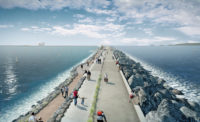The dam will not have a crossbar. “Most of the time, the crossbar, when added, increases the power something like 50%,” says Steijn. Modeling of the 100-km dam showed the crossbar would do little to increase the power, probably because the shore itself does the same job naturally, he says.
Total installed power will be on the order of 10,000 MW. “We made a first tentative estimate of the construction cost for excavation, maintenance, etc., based on European labor costs,” says Steijn. “It’s high, but we’re narrowing it down.” It produced an investment cost of $2-5 per installed watt of power ($20 billion to $50 billion total for 10,000 MW) and 10-15¢/kWh. The installed-watt measure helps establish whether the project concept is feasible, “and it is feasible,” he says. “If you look at tidal free-flow or offshore wind, the investment costs per watt are higher.” The kilowatt-hour cost is lower than offshore wind, a common standard for comparison in Europe.
The POWER consortium is leading the program from the Dutch side. Partners Offering a Water Energy Revolution (POWER) is composed of eight Dutch companies, coordinated by ARCADIS Nederland BV. The team includes Strukton Engineering BV (design and construction), ARCADIS (project management, consultancy and engineering), Pentair Nijhuis Pompen BV (turbine technology), Antea Group/Oranjewoud BV (engineering), WUR-IMARES (Wageningen University, Institute for Marine Ecology), DNV KEMA (energy and sustainability), TU Delft (Delft University, Faculty of Civil Engineering and Geosciences) and H2iD (Hulsbergen’s ocean energy consultancy).
A consortium of nine Chinese companies led by China’s National Energy Administration composes that country’s team. In June 2014, this agency commissioned an economic assessment of the viability of building a DTP facility on China’s east coast. The prefeasibility study to determine economic viability is almost finished, says Steijn.
The published target date for starting construction is 2020, but Hulsbergen says it could be even earlier. “When you look at the infrastructure they are building in just a few years, it is something completely different from what we know in Europe. If the end-of-the-year outcome of DTP feasibility in China’s eyes is positive, they will go full-steam-ahead and might actually break ground within three years.” China’s urgency will be driven by the need to replace coal for energy, he adds.
The POWER group is looking for opportunities worldwide to construct DTP projects. “That cannot be done everywhere because it depends upon many parameters,” Steijn says. It requires a large, shallow sea, appropriate tidal flow and government support. The program has identified the necessary physical conditions in the Irish Sea and off the Netherlands, South Korea and Scotland in addition to China.
No DTP project has been built before, so the environmental impact of a project is not yet extensively studied. The closest comparable project type would be the tidal barrage. The 240-MW La Rance Barrage in France, completed in 1966, was the first and is the most often cited example. “That project featured a closed basin, and it was constructed in situ. The whole estuary was closed off by cofferdams for three years and it was an environmental disaster,” says Steijn. A DTP project doesn’t close off an ecosystem, but it inevitably interferes with its environmental balance, affecting turbidity, fish migration and surface navigation, to name only a few of the most obvious effects.
“We have made a list of about 50 things that will be changed by the dam,” Hulsbergen says. “We and the Chinese have agreed not to look at this question in detail until the Chinese have an idea of the cost-benefit ratio of the dam as an energy generator.” While environmental impact is often thought of as something negative, Steijn sees it as a positive. He cites the effect modeled for a proposed DTP site on the heavily polluted Bohai Sea, which is fed by the Yellow River.
“We found out when we were computing a DTP at the southern side of the entrance to the Bohai Sea, that we also changed the circulation in the Bohai Sea,” helping to remove the pollution, Steijn says. “From a tidal power perspective, that DTP location was not so interesting because of too-high construction cost and too-little output, but if you look at the environmental impact on the water quality in the longer term, it’s a positive.” The Research Institute IMARES, the POWER partner with environmental expertise, is looking at the effect of the tidal powerplant in that location, not just for power generation, but as a way to improve the circulation in the Bohai Sea.
All the costs that they calculate now for the production of electricity—the dam, the civil works, the turbine technology, etc.—are comparable to costs for nuclear power or coal or oil, Steijn says. But the construction of the dam brings with it other benefits as well. For example, the dam can serve as a foundation for wind turbines that will generate additional power, or it can serve as an offshore port facility. “All these additional benefits, if you add that into your cost-benefit calculations, then it becomes much more feasible. It’s a lot of impact, yes, but the impact can sometimes be unprecedentedly positive, so that’s what we want to look for,” Steijn says.


Post a comment to this article
Report Abusive Comment